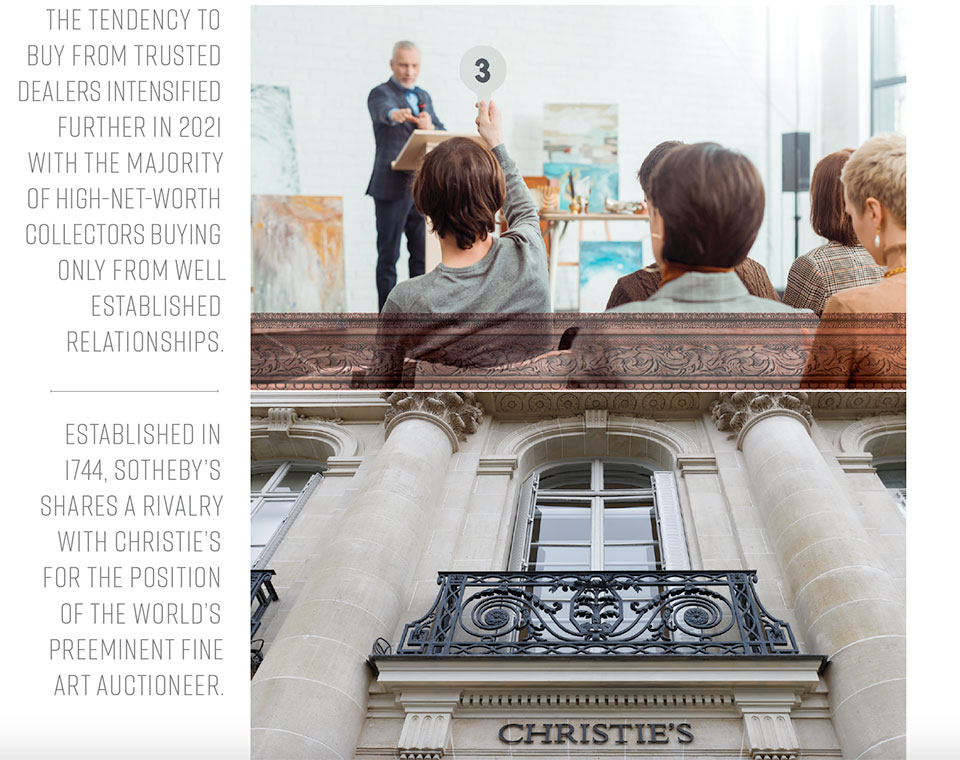ART
A VIEW OF THE MARKET: POST-PANDEMIC TRENDS
by Suzanne Hazlett, MBA, CIMA®, CFP

ART and the CAPITAL MARKETS
Sales of art and collectibles are significantly influenced by the wealth effect created by bullish stock markets.
High net worth and ultra-wealthy fine art collectors have been undeterred from investing in art during the ongoing global health crisis. One year ago, the rearview mirror reflected a dismal reality of steep declines in art sales followed by closures and industry downsizing. Yet 2021 has solidly repositioned a market recovery in our line of sight.
On March 23, 2020, the S&P 500 Stock Index plummeted to 2,237, a drop of 51% from the market’s all-time high just one month prior. It then went on to breach 4,700 in 2021. When stock valuations are rising, consumers increasingly feel financially secure and confident. The resulting wealth effect creates a change in consumers’ perceived wealth and accompanies a shift in spending. Credit Suisse, the global investment banking and financial services firm, reports that the world’s wealthy remain largely insulated from the pandemic’s economic upheaval, citing an additional 5.2 million people who joined the ranks of the world’s 56.1 million millionaires for the first time in 2020.
“If my portfolio is up 30%, it’s reasonable to splurge on a piece of art,” says Doug Woodham, managing partner of Art Fiduciary Advisors and a former Christie’s president.
In September, renowned cultural economist and founder of Arts Economics Dr. Clare McAndrew completed her annual research and published Resilience in the Dealer Sector. This year’s key findings in McAndrew’s study show that more than half of art dealers reported an increase in sales and collectors remained engaged. And with millennials leading the way, female spending rose at the same time female artists became more prominent, digital acceleration continued, and sustainability is top-of-mind with collectors.
To appreciate some of the shifted perspectives, in the pages that follow, we’ll offer a glimpse of the art market’s generational divide, define the increasing presence of non-fungible tokens, and consider the changing roles of industry intermediaries.

GENERATIONAL DIVIDE: BOOMERS + GENERATIONS X, Y, and Z
Millennial art collectors have spent more than three times the level of Gen X & Boomers.
Avid and financially-able collectors have been essential in helping the art market endure the pandemic-induced economic contraction. Specifically, the fortitude of the market has been significantly bolstered by millennial collectors who are spending three times more on art than their older peers.
Generational timelines aren’t exact, but they offer us lenses through which we can see the cultural experiences, technological advances, and politics that may have a lifetime influence over a group’s values and purchasing habits.

Generation Z is the nascent cohort of collectors with birthdays between 1997 and 2012. Millennials (also called Generation Y) are widely defined as those born within the 16 years of 1981 to 1996. By definition, those born between 1965 and 1980 are members of Generation X, and Baby Boomers represent the surge of post-WWII births that spanned 19 years until 1964.
Millennials comprise one-quarter of Christie’s global clientele in 2021, an increase of 15% from 2019. Christie’s chief executive Guillaume Cerutti has said that the auction house’s average bidder is now 46 years of age, two years younger than at the start of the pandemic.
One-third of Sotheby’s collectors are under 40, representing their comparatively youthful pursuits with focused bidding on contemporary collectibles and non-fungible token artworks.
Bank of America Art Services has found that the newest population of affluent collectors tends to fall into four groups: young entrepreneurs, rising hedge fund and private equity professionals, digital and crypto fans, and rising stars in the sports, fashion, and entertainment sectors.
The global consultancy firm Bain & Company sees the luxury industry, including art, successfully rising out of the viral crisis by transforming its operations to meet new customer demands and retain relevance, especially for younger generations. Bain sees the younger generations as the biggest buyers of luxury goods and art, representing two-thirds of global purchases.
Millenial art collectors were the highest spenders in 2020, with a median expenditure of $228,000.

NON-FUNGIBLE TOKENS
Cryptocurrency NFTs can be used to commodify digital creations, such as digital art, video game items, music, and collectibles.
Essentially, NFTs are like physical collector’s items, only digital. Instead of acquiring a painting or a sculpture, the buyer receives a digital file instead. A fungible token, in contrast to an NFT, is by definition exchangeable or replaceable. NFTs are different.


An NFT is an intangible asset that exists only in a digital universe. You can’t touch it, but you can own it. Still don’t understand what all the fuss is about? You may not be alone. Some experts feel that NFTs’ prices are reaching a bubble. Others believe that NFTs will continue to evolve and will change art investing forever.
Digital art has attracted the spotlight in 2021 with the growth of transactions via NFT platforms and several high-profile sales. Famous digital artist Mike Winklemann, commercially known as “Beeple,” created a collection of 5,000 daily drawings to create the NFT entitled EVERYDAYS: The First 5000 Days, which was auctioned at Christie’s in 2021 for $69.3 million.

Crypto-artists and collectors can find each other on blockchain marketplaces where artists can upload, market, and sell their work. From a collector’s viewpoint, the value of an NFT is based solely on demand for it. An NFT may lose some or all of its value if interest dissipates. Also, if you sell an NFT at a profit, expect to pay capital gains taxes as you would with the profitable sale of traditional assets.
Some buyers of NFTs have been investors in cryptocurrencies for years. They see NFTs as a way to diversify their positions in digital currency. The excitement over digital art will likely fluctuate; the increasing acceptance of cryptocurrency and the underlying technology may have some enduring impact on the art world.
AUCTION HOUSES + OTHER INTERMEDIARIES
At auction houses the message is the same: the art market is thriving.

Auction sales more than tripled in the first half of 2021, with the major auction houses – Christie’s, Sotheby’s, and Phillips – reporting collective sales of $5.8 billion by June 30 of this year, a 230% year over year increase. Increased buying options are cited as a factor for the rise in sales, namely the return of the live auction format and the traditional calendar as well the online channels.
Nevertheless, Christine Bourron, the chief executive of Pi-eX, a provider of analytic tools for collectors and art investors, says, “It’s indisputable that virtual auctions and the advent of NFTs and the skyrocketing popularity of authenticated blockchain artwork also hugely contributed to the large bump in sales numbers that auction houses are currently enjoying.”
Charles Stewart, Sotheby’s chief executive, said online audiences bidding during livestream sales now outnumber people calling by phone to bid. “Physical and digital, we’re ambidextrous now.”

For galleries, the pandemic era and the lockdowns that ensued presented a challenging environment to conduct business through traditional means of in-person events, openings, and art fairs. Yet, in her A Mid-Year Review 2021, Dr. Clare McAndrew cites a 51% increase in gallery sales during the first half of 2021 compared with the first half of 2020, along with a gradual return of the dealers’ audiences to live events. While collectors’ digital access to galleries has enabled dealers to retain and nurture their client relationships, most collectors still opt to view and purchase art in person when given a choice.
McAndrew further found that digital technologies have impacted art market infrastructures, allowing for more direct communication between collectors and creators, potentially reducing the importance of intermediaries.
DIGITAL FUTURE
Within their view, Bank of America Art Services sees the art market entering a new demand-driven growth cycle. Fueled by low-interest rates, advancing stock market ultra-high-net-worth wealth creation, digital channels, and a new demographic of collectors, BofA’s art division unflinchingly predicts that the art market is poised to reach new heights. “We’re seeing business models innovate at a pace they haven’t achieved in over a decade,” says Dana Prussian, vice president of art services at Bank of America. Even though many have never attended an art auction or fair, an entire generation of younger international buyers are embarking on art spending sprees.
According to McAndrew’s 2021 Global Art Market Report, online sales continue to advance at a feverish pace, accounting for 37 percent of all dealer sales, including sales made via online viewing rooms. In addition to using technology as a tool to view and purchase art, nearly half of the collectors surveyed in her report conveyed an interest in acquiring digital artworks. A primary question concerning the market now is how easily the digital and physical art worlds will merge.
For the coming year, the outlook for the art market is roughly aligned with that for the global equity market. Like other consumer sentiment-driven acquisitions, art sales are likely to benefit from consumer liquidity. Excess savings have accumulated along with pent-up demand as personal wealth has grown over nearly two years while avenues to spend it have been limited.

“Collectors know exactly what they want from art: more. A lot more.”
–Wall Street Journal
Suzanne Hazlett, MBA, CIMA®, CFP®, is a Certified Investment Management Analyst® and CERTIFIED FINANCIAL PLANNER professional. Nonfinancial assets, such as fine art, are complex and involve risks, including total loss of value. Special risk considerations include natural events, complex tax considerations, and lack of liquidity. Nonfinancial assets are not in the best interest of all investors. HAZLETT WEALTH MANAGEMENT, LLC is independent of Raymond James and is not a registered broker/dealer. Investment advisory services are offered through Raymond James Financial Services Advisors, Inc. Securities offered through Raymond James Financial Services, Inc., member FINRA/SIPC. 675 Sun Valley Road, Suite J1 + J2, Ketchum, Idaho, 83340 208.726.0605 HazlettWealthManagement.com.